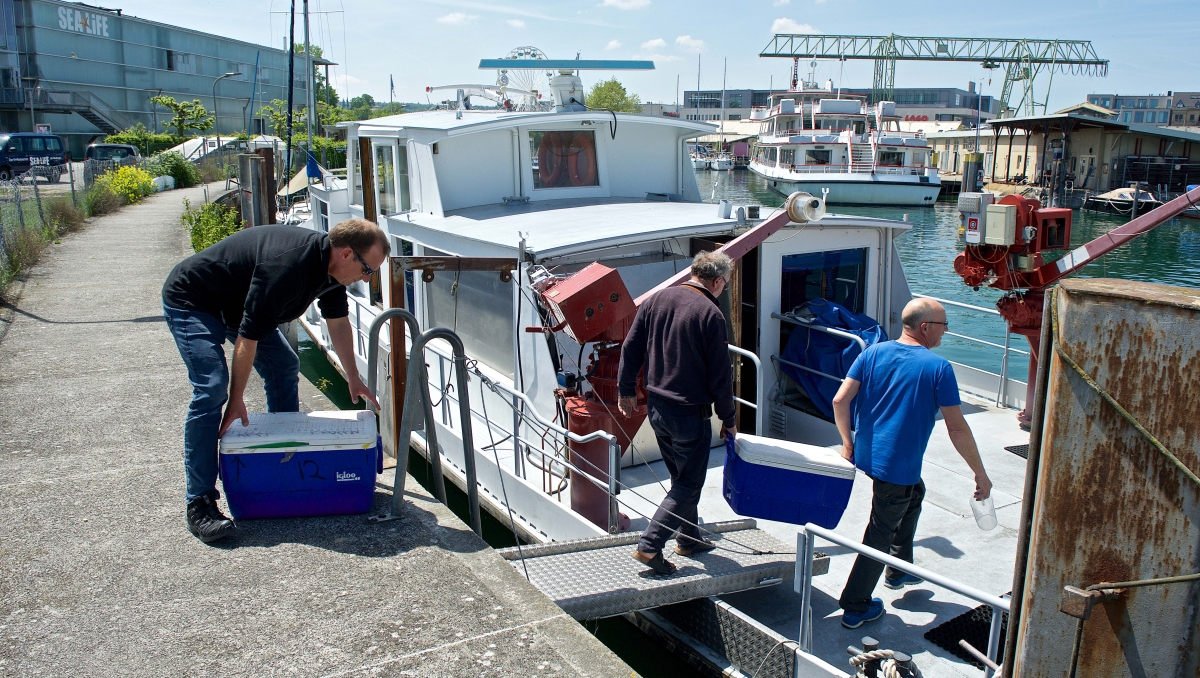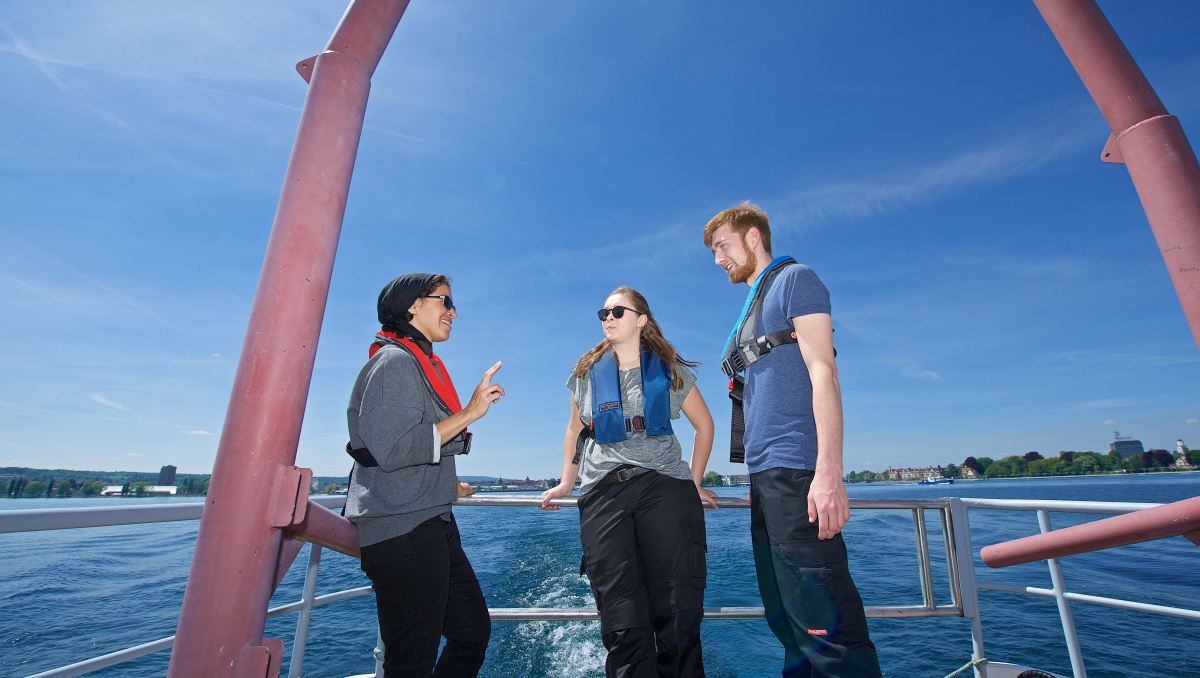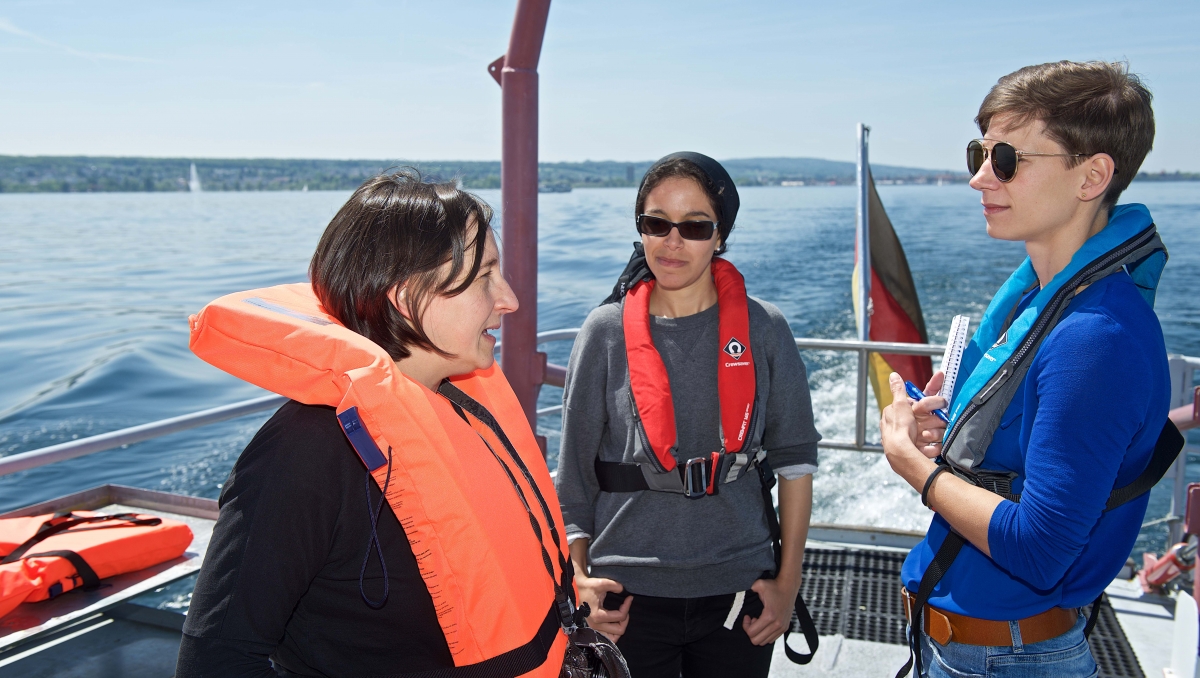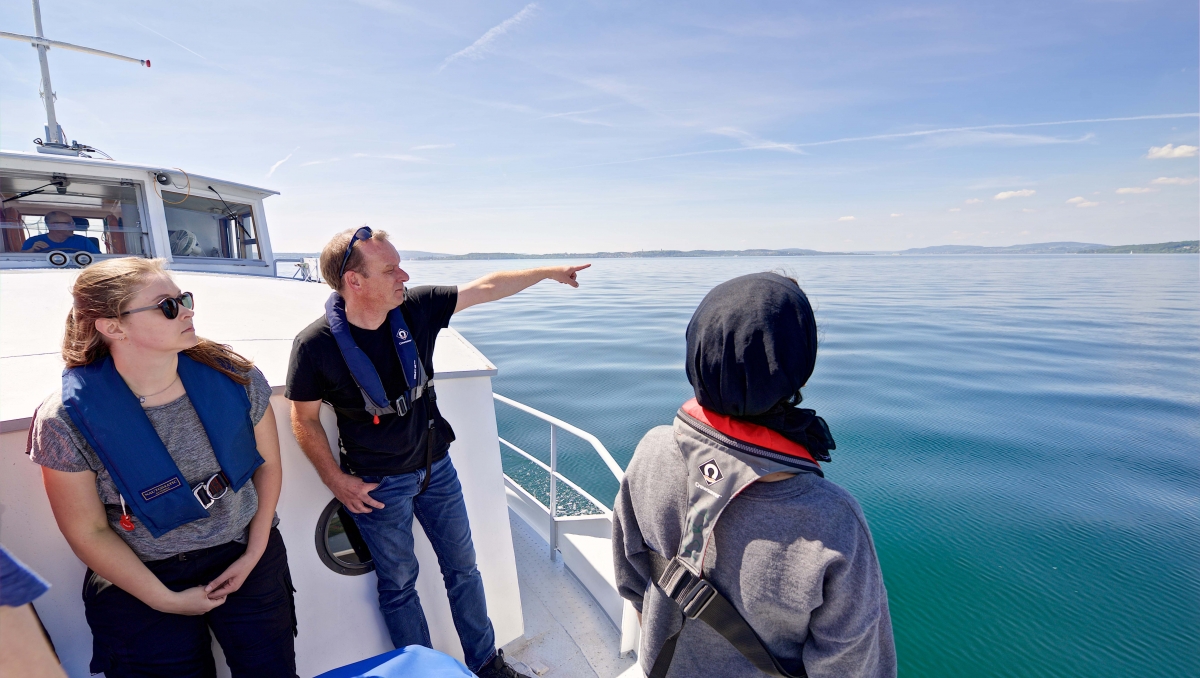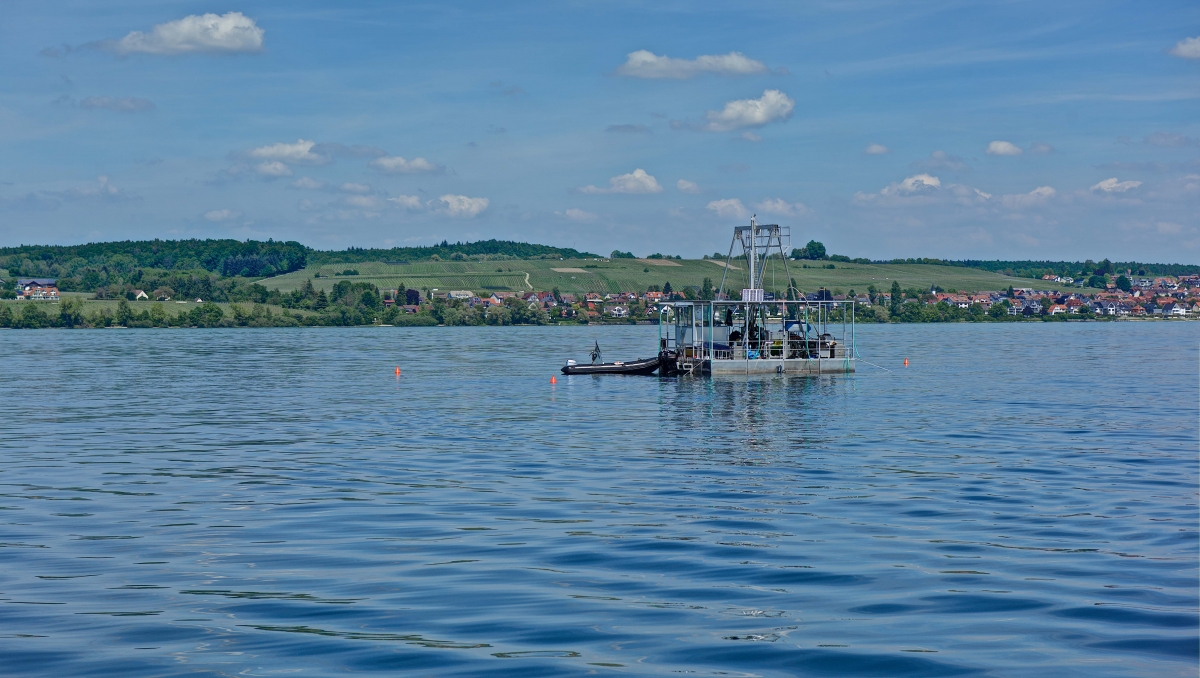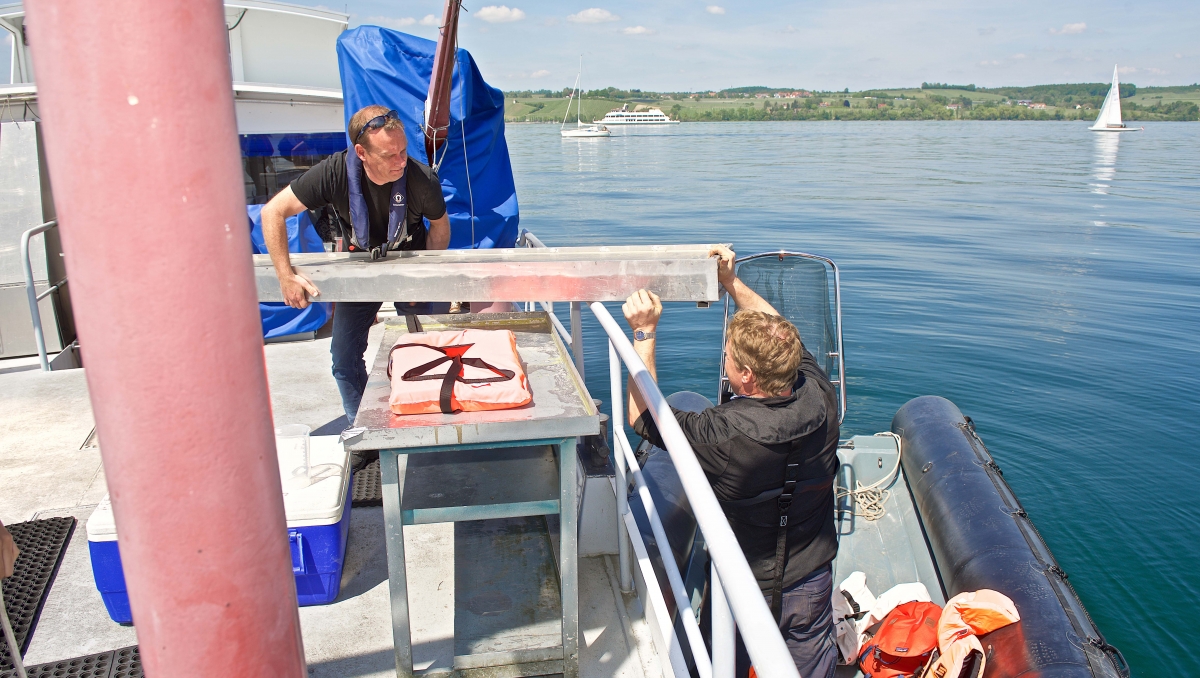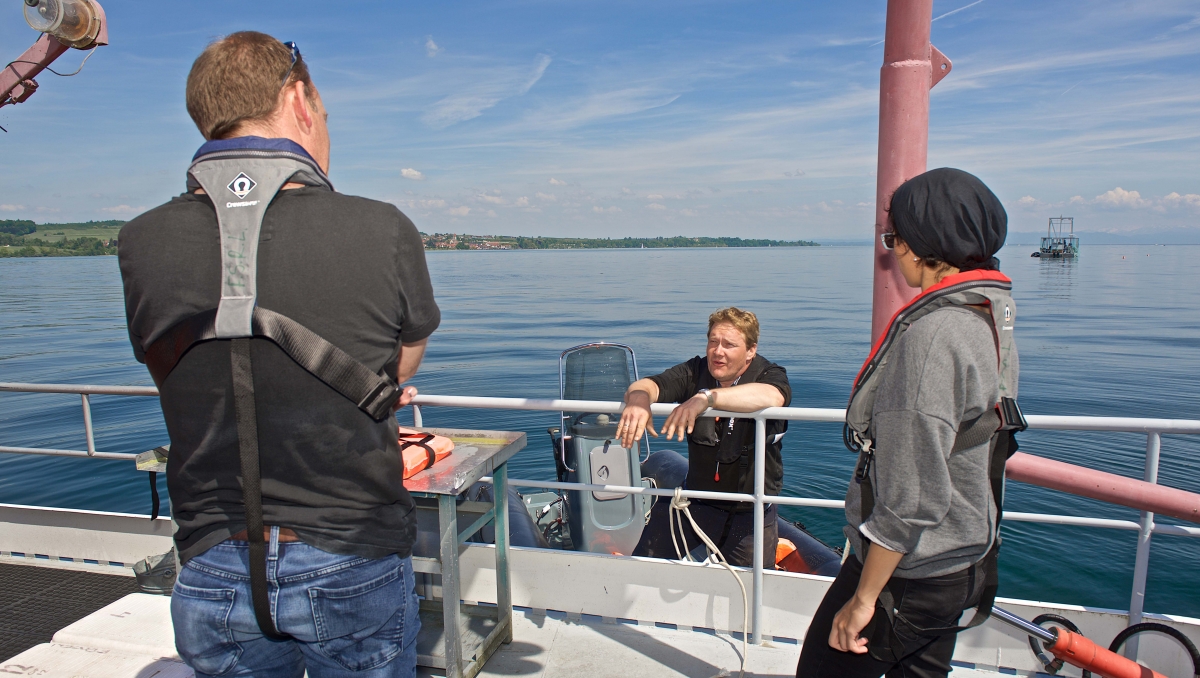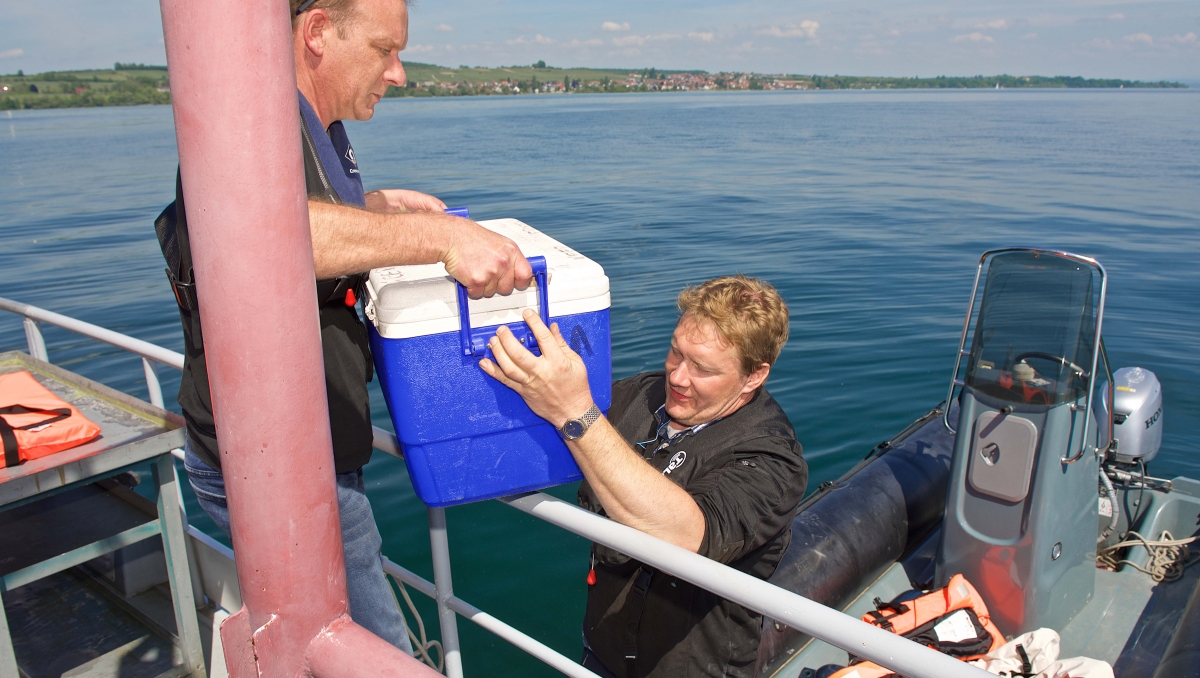- 1Bringing clues from the ice ages to light
- 2Researcher questions
- 3Direct Push
- 4Video: UWITEC drilling equipment for extracting sediment samples
- 5Information about HIPERCORIG
- 6Photo gallery: drilling platform
- 7What are the next steps?
- 8Introducing Laura Epp
- 9Earlier studies
- 10Tracing significant changes
- 11Introducing David Schleheck
- 12Optimal conditions via well-functioning infrastructure
- 13First indications
- 14Exciting weeks and months

Bringing clues from the ice ages to light
Scientific research has many faces. For an international research team from Germany, Austria and Switzerland, it is a journey into both the depths of Lake Constance and the distant past: What was life like in and around Lake Constance during and since the last ice age? Which biological communities can be identified on the basis of the genetic material found in the sedimentary deposits of the lake bed? What do these residues reveal about the effects of past climate change on local species and populations? And which microorganism communities are still active in these old sediment layers?
Two biologists from the University of Konstanz, Professor Laura Epp from the Limnological Institute and Dr David Schleheck (Privatdozent) from the Department of Biology are working on finding answers to these questions as part of an international research project involving geologists and geochemists led by Professor Antje Schwalb from the Institute of Geosystems and Bioindication at the Technische Universität Braunschweig. The aim of the project is to develop a historical overview of the Lake Constance region’s climate and environment as well as their effects on the lake ecosystem. In order to recover core samples from the lake bed and then carry out geological, geochemical and biological analyses of their contents, the researchers are utilizing the state-of-the-art and specially developed HIPERCORIG drilling platform in combination with the sampling system “Direct Push”, which can penetrate up to 100 metres deep into the sediment of the lake floor at a water depth of 200 metres.

“Direct Push” is installed on and operated from the HIPERCORIG platform measuring six by eight meters, which is moored about two kilometres south of Hagnau in Lake Constance. The system consists of a piston core barrel driven by a down-the-hole-hammer, which together comprise technological advancements in the mining and foundation engineering sectors. It allows the researchers to carefully recover the sediment cores, keeping the fine stratification of the sediment sample intact. The Hagnau location was selected due to its seismic profile: the sediment layer is especially deep there, allowing the researchers to retrieve sediment cores from a great depth.
The proposal for “HIPERCORIG” was submitted jointly by the Technische Universität Braunschweig and the Bochum University of Applied Sciences with the support of the Deutsche Forschungsbohrkonsortium (GESEP) e.V. and funded via the priority programme SPP 1006 – International Continental Drilling Program (ICDP) by the German Research Foundation (DFG) with EUR 1.1 million between 2016 and 2018. The system was built by the Austrian company UWITEC, which specializes in the design and development of such drilling technology. Further project partners include the Institut für Seenforschung der Landesanstalt für Umwelt Baden-Württemberg, the Helmholtz Centre Potsdam - German Research Centre for Geosciences, the Leibniz Institute for Applied Geophysics in Hanover, the Leibniz Institute for Baltic Sea Research Warnemünde and the University of Bern in Switzerland.
Due to its small size, the platform can be transported in a few containers and set up without cranes. Once it completes its work on Lake Constance, it can be used for other national and international research projects in remote and difficult to access areas around the world. After experiencing some weather-related delays, the researchers are planning to complete their sampling work by 15 July. Find out more about the work carried out on the drilling platform on the blog of the TU Braunschweig.
Once the work on Lake Constance is completed, the researchers can then begin with the actual scientific work. The sediment cores will be stored and studied at the University of Bern, where researchers will focus on palaeoclimatological topics. In order to find out more about the climatic conditions in the past, it is necessary, among other things, to identify and measure the amount of planktonic remains in the various sediment layers.
Before the cores are transferred to Switzerland, however, several researchers from the University of Konstanz’s Department of Biology will examine them for remains of ancient DNA and active microorganisms. In order to prevent potential contamination of the sediment, Laura Epp, David Schleheck and doctoral student Anan Ibrahim will take take great care to remove small samples from the approximately two-metre-long cores in a specially equipped cold storage room at the university. They hope that their paleolimnological and microbiological investigations will provide answers to questions that have so far eluded them, due in part to insufficient technical capabilities.
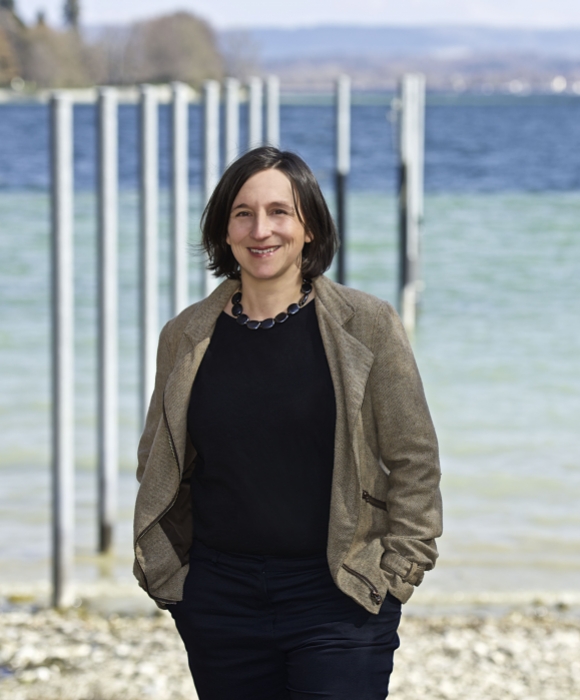
Laura Epp: Ancient DNA and the history of Lake Constance
Laura Epp investigates both ancient DNA (aDNA) and environmental DNA (eDNA) contained in the sediments and waters of Lake Constance in order to learn more about local ecosystems and their development over time. She is particularly interested in the historical development of the ecosystems and their effect on the current biodiversity in the lake, which includes both biological communities and individual species. Her research aim is to not only assess both climate and human effects on past biodiversity, but to also predict future effects.
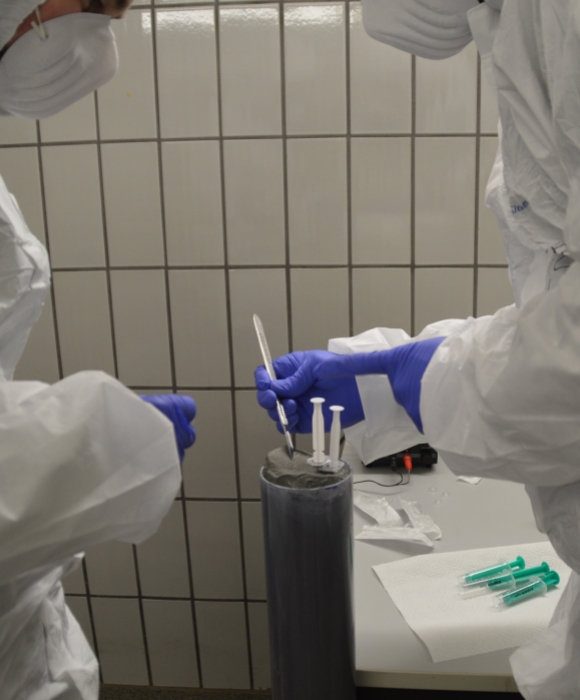
She uses the sediment cores extracted via HIPERCORIG and the “Direct Push” sampling system to examine the sediment for traces of ancient DNA (ancient DNA is DNA that is older than one hundred years). “I’m interested in answering the following questions,” explains Laura Epp: “How variable was Lake Constance before the twentieth century? We are very familiar with the eutrophication history of the lake and thanks to Anan Ibrahims doctoral thesis, we also know that the associated changes are very well documented in the genetic data. But what occurred before then? In addition to having a long geological history, Lake Constance also has a distinctive history in regard to human influence”.
Earlier studies from the 1990s on a previously extracted sediment core clearly show that the lake ecosystem was affected by climatic changes. Between 6000 and 2800 years ago, however, these changes coincided with increased human settlement on the shores of the lake. But this data does not confirm a link between these climatic changes and human activity. “I am particularly interested in finding out if and how the twentieth century stands out in this context – keyword anthropocene. Can this time period be compared to previous climatic developments in terms of intensity and speed? Is it comparable in the way the entire ecosystem was genetically modified?”

Should the new core samples contain ancient DNA, Laura Epp will examine it in order to trace significant changes in the past, all the way back to last ice age. “Lake Constance is a great model system for this type of study because I can incorporate long periods of climate history, early settlement and intensive human activity into my research”. The core samples that she will be examining will be simultaneously studied by David Schleheck from a microbial point of view (more on his research project below).
Additional analyses are being carried out for researchers at other institutions who are involved in the project but cannot be on site. Amongst other things, they are interested in analysing pore water, sulphate reduction and methane formation. These tests must be carried out on fresh and unaltered cores before chemical and biological reactions can adversely affect scientific measurements, thereby distorting the resulting findings.
In the future, Laura Epp hopes to gain further insights from the cores once they are made available in their entirety at the University of Bern in Switzerland. “Here at the University of Konstanz, we can only take samples from the core’s centre. We will be able to obtain a more complete picture when the cores are cut lengthwise and comprehensively analysed in Bern. These cores will provide us an incredibly exciting perspective into the past.”
David Schleheck: A boost for old microbial life
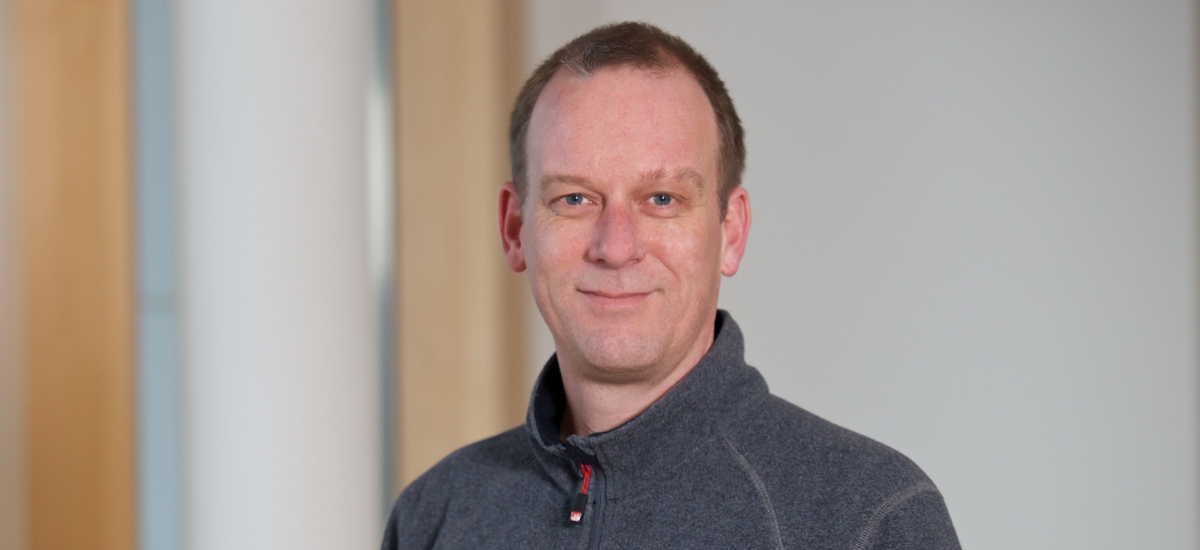
David Schleheck is a microbiologist who leads a research team on Microbial Ecology at the University of Konstanz. His research is funded through the Heisenberg Programme of the German Research Foundation (DFG). His research is focused in particular on answering the following question: How do microorganisms nourish themselves in their environment and thereby contribute to global material cycles? In the context of the HIPERCORIG project, however, he is also focusing on DNA-based investigations. These will allow him to identify still active microorganisms in the ancient sediment layer samples extracted from Lake Constance.
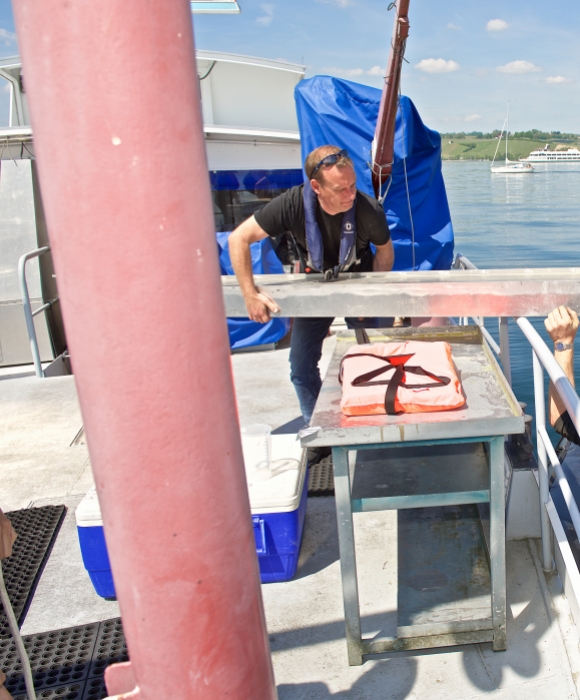
“We are now able to take both aDNA samples for the collaboration project with Laura Epp and microbiological samples, both under optimal conditions. This is a first for us at the University of Konstanz,” declares Schleheck. To be able to study the few existing microorganisms under natural conditions, the researchers must ensure that these conditions are maintained – including cooler temperatures – while the samples are moved from the bottom of the lake to the surface and then to the laboratory.
A well-functioning infrastructure is extremely important for this, explains the researcher: “We would like to take this opportunity to thank our colleagues from our university’s Scientific Engineering Services. Not only did they design and construct the two-metre-long insulation boxes for the transportation of the sediment cores, but they also helped us to optimize the tools required to quickly open the core casings – all on short notice.”
To be able to identify both the organisms that are still living in the deep sediment layers of Lake Constance and the metabolic processes that have enabled them to survive, the researchers need to ensure that the bacterial communities are not affected by the transport. To this end, they need to maintain a constant temperature of four degrees Celsius for the cores as they are moved to the laboratory. Furthermore, the organisms need to be moved under the anoxic conditions they are used to in their natural habitat: “Oxygen is actually toxic for most of these life forms,” says Schleheck.
There are already indications that organisms such as Atribacteria or so-called Hadesarchaea are specialized to live in this deep biosphere. “Nutrients have become very scarce at those depths. With a relatively high metabolic expenditure, these organisms are able to produce and maintain enough energy to survive by taking advantage of special respiration and fermentation processes as well as metabolic coupling mechanisms,” explains Schleheck.
And the organisms grow very, very slowly, if at all: “Life is an extremely slow process for them. While a bacterium such as Escherichia coli can double its population approximately every 20 minutes under optimal conditions in a laboratory, microorganisms in deep sediment layers require months, years or even decades to double their populations – if they aren’t in a dormant state or 'deep sleep'. Even if we are able to simulate their growth conditions in the laboratory, it might take a long time before the microorganism populations grow into large enough groups for us to carry out a normal physiological-biochemical analysis on them.”
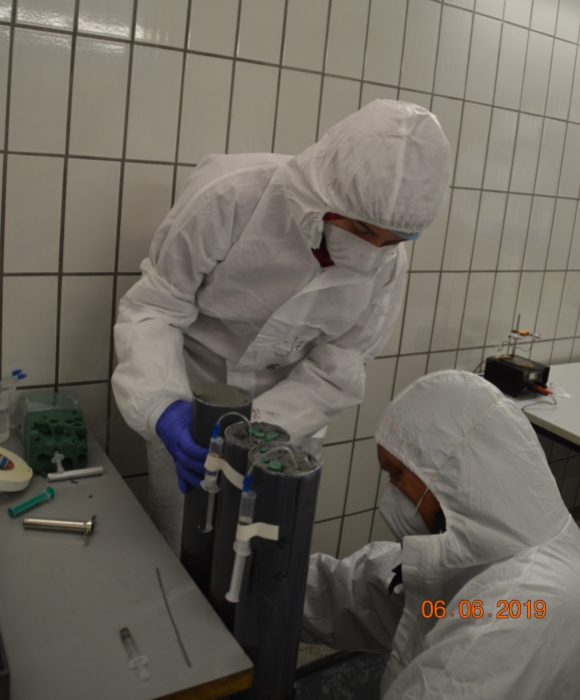
Schleheck is therefore planning to first extract the entire microbial DNA from the sediment samples via a cultivation-independent research approach, and then sequence it using a so-called shotgun sequencing method. “This method will allow us to read the 16S rDNA sequences of the microorganisms – their name tags, so to speak – and maybe even reconstruct their complete genome sequences.” The genetic information can then be used to identify the specialized metabolic processes the organisms use and to find out how they nourish themselves. “The analytical-chemical examinations of the sediment material and the pore water will also provide us with important information about their living conditions,” explains Schleheck.
The researchers just recently sampled a core extracted from a depth of 14 metres, an already very sandy sediment that probably dates back to the last ice age, the Würm Glacial about 14,000 years ago. “Only a few metres further, and we will have arrived in the sediment of the 'old' Lake Constance”, says Schleheck with a smile. With a maximum drilling depth of 100 metres, Laura Epp and David Schleheck have very exciting weeks and months to look forward to.
